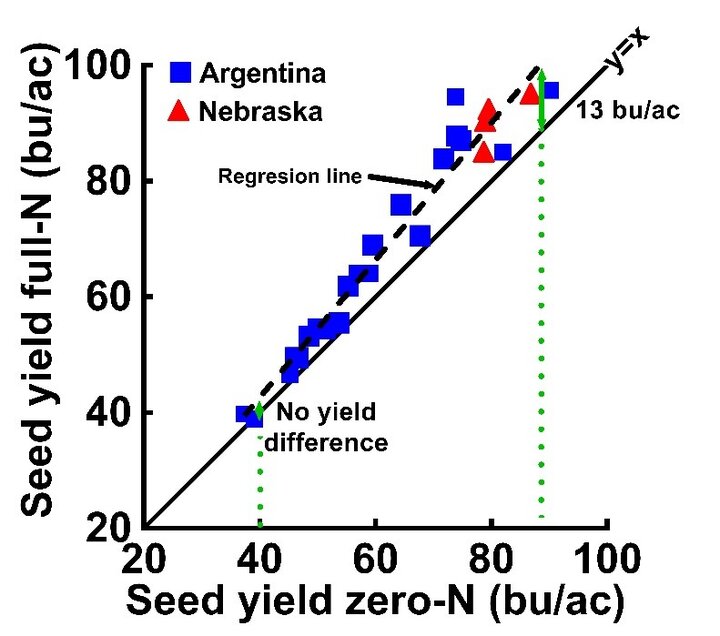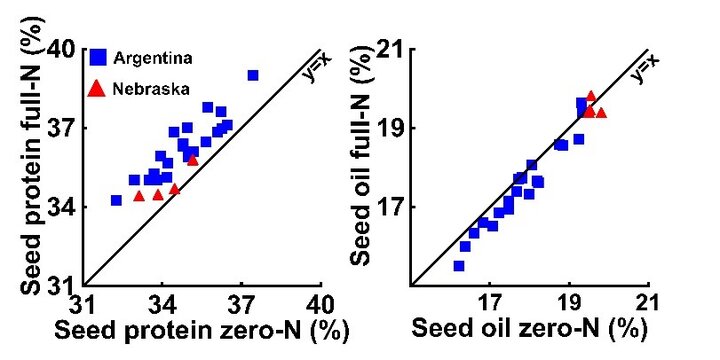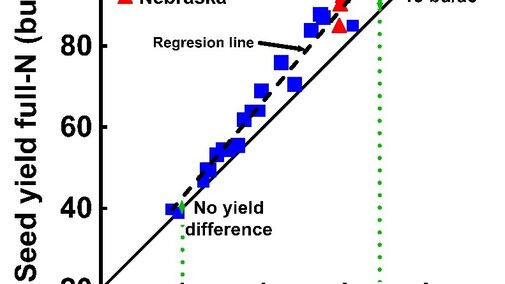Soybean has a large nitrogen (N) requirement. Indeed, soybean requires about four times more N per bushel produced than corn. On average, soybean needs to absorb 4.8 lbs of N per bushel produced. Hence, a soybean crop that produces 50 bu/ac (similar to current Nebraska average) will need to absorb 240 lbs N per acre. In contrast, a well-managed, irrigated crop that produces 80 bu/ac will need about 384 lbs N per acre.
Except for a small dose of N fertilizer applied as “starter” in some fields, most soybean crops rely almost exclusively on N supplied by soil organic matter mineralization and N fixation. The latter is a symbiotic association between a bacteria and the plant. The bacteria fixes N from the air and makes it available for the plant in exchange for carbohydrates that come from plant photosynthesis.
As the yield levels increase, so does the N requirement, leading to uncertainty relative to the degree to which the N supplied from soil organic mineralization and fixation is sufficient to meet crop N requirements. Therefore, it seems critical to know the level at which soybean yield becomes limited by N supply, if it ever does. However, it is challenging to evaluate N limitation in soybean for two major reasons. First, soybean absorbs 60% of the N after R3 (beginning of pod setting), so it is difficult to ensure an ample N supply just when it is really needed by the crop. Second, application of N fertilizer in soybean (and other legume crops) typically results in a decrease in N fixation. In other words, applying N fertilizer reduces N fixation so that the amount of N absorbed by fertilized versus non-fertilized crops may end up the same. These two reasons help explain why yield response to N fertilizer has been found to be small and inconsistent in past soybean research.
Our Experiments
As a first attempt to understand the degree of N limitation across yield levels in soybean, we designed an experiment that includes:
- a “full-N” treatment that received ample N supply during the entire soybean crop growing season, and
- a “zero-N” treatment that did not receive any N fertilizer.
Our experiments were conducted in irrigated soybean in Nebraska (four producer fields near Mead, Saronville, Atkinson, and Smithfield) and Balcarce (Argentina) from 2015 to 2017. The experiments covered a wide range of environments, with yield ranging from 40 to 90 bu/ac. A side-by-side comparison of yield in the full-N versus zero-N treatment at each site would provide a good indication about the degree of limitation across this wide yield range.
Our full-N treatment received large N fertilizers amounts (ranging from 300 to 780 lb N/ac), which were determined based on 1) site-specific yield potential as determined by climate and genetics and 2) the soybean N requirement per bushel produced (4.8 lbs N per bu). Because of the “trade-off’ between N fertilizer application and N fixation, we ignored N fixation for our calculation of N fertilizer requirements. Again, these N fertilizer amounts were applied to test our hypothesis about N limitation in soybean and not to make recommendations regarding N fertilizer application in farmer fields!
To guarantee a high N supply during the entire growing season, the total N fertilizer amount calculated for the full-N treatment was split into five applications (V2, V4, R1, R3, and R5 stages). The amount of N fertilizer in each application was proportionally adjusted according to the expected crop N requirement at each stage: 10% at V2, 10% at V4, 20% R1, 30% at R3, and 30% at R5. In other words, we “spoon-fed” our soybean crop during the entire growing seasons to ensure that N supply was perfectly synchronized with the crop N demand.
What Did We Find?
Figure 1 shows the comparison between measured yields in the full-N treatment (vertical axis) versus the zero-N treatment (horizontal axis). The colored symbols denote the yields of soybean at each site and year. The solid x=y line denotes equality in yield if soybean yield is not impacted by N fertilization. However, the chart’s dashed line shows that soybean yield was indeed impacted by N fertilizer addition.
On average, seed yield was 11% higher in the full-N treatment compared with the crops that did not receive any N fertilizer (zero-N) (Figure 1). However, the yield responses depended upon the yield level of the environment. For example, there was no seed yield difference between full-N and zero-N treatments for yield levels around 40 bu/ac. In contrast, there was a 13-bushel yield increase due to N fertilizer application at yield levels near 90 bu/ac. To summarize, our results indicate that soybean yield is indeed limited by N supply, especially in high-yield environments.


N protein concentration typically decreases with higher yields. We found the opposite response in our experiments: despite higher yields, seed protein concentration was higher in the full-N versus zero-N treatments (36.0% versus 34.7%). In contrast, oil concentration decreased slightly in the full-N treatment (Figure 2).
Take-Home Messages
Although our study used N rates that are far from being economically profitable and environmentally sound, it clearly shows that:
- Nitrogen supply from soil organic matter mineralization and fixation are NOT sufficient to fully satisfy soybean N requirement, especially in high yield environments.
- Yield response to large N fertilizer amounts was modest and depended on the yield level of the production environment (5 bu/ac at 50 bu/ac yield level, but 13 bu/ac at 90 bu/ac yield level).
- Seed protein concentration increased with N fertilizer addition, a surprising finding worthy of more research.
- As soybean yield continues to increase, the N limitation will become more and more important. Hence, future research should be directed to 1) find agronomic practices that can “break” the trade-off between N fertilizer addition and N fixation and 2) increase N fixation.
- If you are considering an N application in soybean, keep expectations at a reasonable (low) level and give priority to fields with consistently high yields in previous years.
References
Cafaro La Menza N, Monzon JP, Specht JE, Grassini P. (2017) Is soybean yield limited by nitrogen supply? Field Crops Res. 213, 204-212.
Grassini, P., Rees, J., Cafaro La Menza, N., and Specht, J., 2016. What does it take to produce 80+ bu/ac soybean? (EC 3000) UNL Extension Circular.

